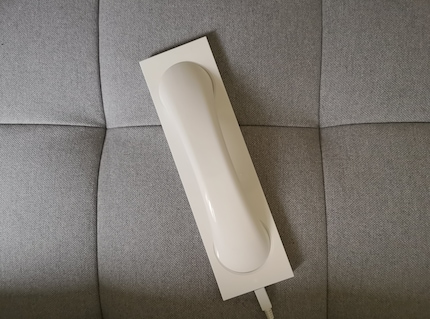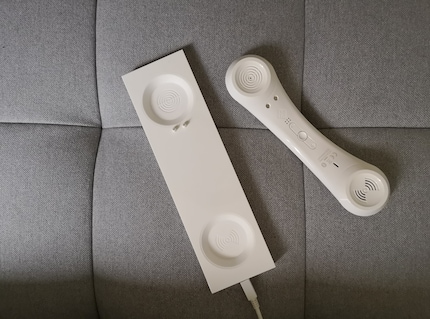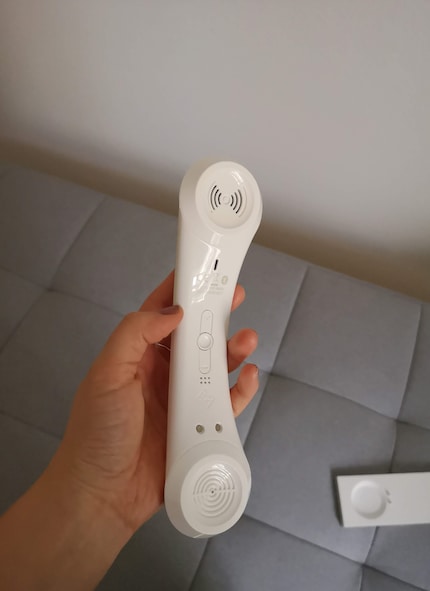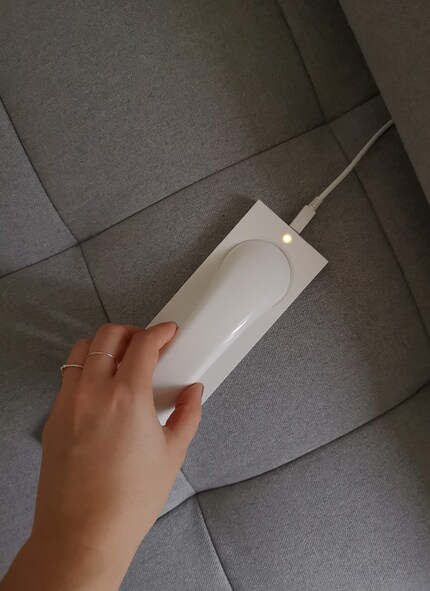

When hardware becomes soft #5
I keep coming across surprising things in our range. Most recently, telephone handsets that are connected to a smartphone via Bluetooth or cable. Strange, I actually thought that handsets were passé. Do we want to "hang on the wire" again?
If a designer wants their product to be intuitive to use, they need to closely observe the environment in which it is to be used. This enables them to calculate the opportunities and hurdles of the design in everyday life and strive for user-friendliness. Because peripheral manufacturers such as Native Union are launching new handset docks with a retro look, I wonder whether designers have realised that we humans are missing something in our everyday use of smartphones.
What is the appeal of old phones?
The telephone has opened up new ways of communicating. It appeals to our sense of touch - especially when a cord is involved - and it is chic. As an object, it stands on its own and, in the case of the Native Union handsets, contrasts with the virtual world with its soft shape and surface. As a millennial, the handsets remind me of the nineties. They probably already look exotic to Generation Z.


I haven't had a phone since I left home. This is partly because I first lived in a shared flat where no one attached any importance to a landline and partly because a mobile phone with a video function and apps like Skype gives me more options for communicating. Now that I'm living alone, I'm giving it a try and buying the "Pop Phone Curve" Bluetooth handset from Native Union to answer my question as to whether everything was better with a handset. Maybe I'm missing something I don't know about?

Haptics revival
For me, gadgets are beautiful when their shape hides their technology. This handset does just that. It is so pure that it could pass for a sculpture. Only the cradle and charging cable hint at what the object can do.


The first time I touch the handset, I get a feeling of familiarity. Compared to my bulky smartphone, I find the handset easy to grip, light and intuitive to use. It doesn't take long and then I'm clutching the handset around my neck and walking around the flat like in the old days. The sound quality is also a lot better. What I enjoy most are the buttons for hanging up and answering calls. I like the fact that the buttons give me feedback and fulfil my expectations. This handset also allows me to make calls using programmes such as Skype. And best of all, I'm not tempted to use other apps at the same time because my smartphone is somewhere else.
Less multitasking
In the past, I didn't want to own a landline because in my millennial mind it was synonymous with being stuck. Now I have to admit that the immobility of "Pop Phone Curve" puts me at ease. The one thing I often miss when I'm on the phone is being aware of the person I'm talking to. I can make phone calls between door and door and anywhere when travelling, but I don't have anywhere near as intense a conversation as when I'm talking to someone at home. I remember talking to friends and family on the phone for hours at home when I was a teenager. No incoming tram, clinking crockery in a café or noisy passengers on the train could disturb me. Maybe it's the nostalgia I'm feeling, but it's actually okay not to be mobile all the time.
Counter-movement to technical progress
The trend of consciously foregoing mobility goes further than handset docks: today, unsmart mobile phones, so-called feature or dumbphones, are being reintroduced: The banana mobile "Nokia 811" is one example. It mimics the original from 1996. The new version has additional features such as a 2-megapixel camera, 4G functionality or a charge of up to 25 days on standby time.
In contrast to upcoming 5G smartphones, the retro model is not being hyped for its 4G, but for its ergonomic design and the fact that you can be offline with it for days on end. According to Nokia, it is suitable for weekends when you want to relax. I trust Nokia and Native Union that this assumption is based on observation. Designers seem to have realised that people want to get by again without wifi and mobile data in their everyday lives or on holiday.
Admittedly, I also have a tendency to be offline as much as possible when travelling. But I can't do without it completely. I would miss something at home if I no longer had a Bluetooth handset. Also because it's a great conversation starter with guests: "Is that another old phone from the local shop?" I was asked recently. "Something like that," I replied. "It's a new one and from Galaxus." 😉
Retro models with a wire or Bluetooth function
Retro telephone handset
What do you think of the trend?
- I can make relaxed calls with my smartphone even without an extra handset.77%
- I'd even take the trendy handsets out on the street as a gag.13%
- I have my landline and still literally pick up the phone.15%
The competition has ended.
Follow me for the next "When hardware goes soft" article by hitting the little black "Follow author" button on my profile. I look forward to your plan.
Like a cheerleader, I love celebrating good design and bringing you closer to everything furniture- and interior design- related. I regularly curate simple yet sophisticated interior ideas, report on trends and interview creative minds about their work.